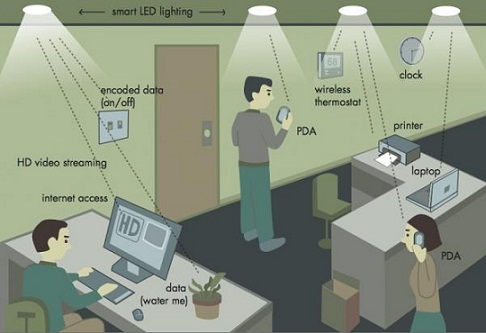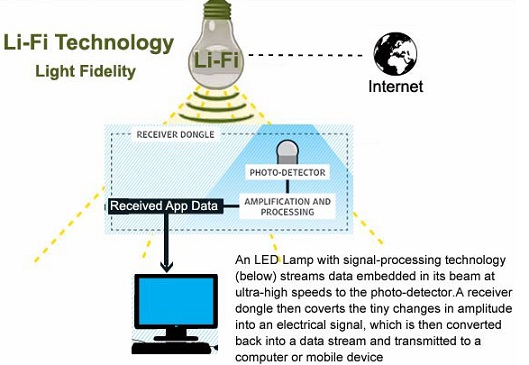As we all know that light arrives at everywhere. Suppose if definite information is to be transferred by using light as medium. Not only the communication will get faster but also possibilities coming with it. Such technique of using Light as medium is termed as the Li-Fi
Wi-Fi:
Wi-Fi stands for Wireless Fidelity
It utilizes 2.4 to 5 GHz radio frequency to transport wireless Internet access around our homes, offices, schools and in public places.
Major problem with Wi-Fi
Bandwidth is normally limited to 50-100 megabits per second (Mbps) today by using IEEE802.11n standard.
It functions fine with many of internet connections. But it is not capable to transport High Definition Movies, music libraries or video games.
With current increase in use of cloud computing (where you store the information on certain web server and not on your local disk), Wi-Fi is not going to be useful in future as it will not be capable to provide to need of increasing bandwidth and speed.

What is Li-Fi?
Li-Fi is most recent communication technology which can broadcast data using spectrum of visible light. Other names for Li-Fi: Optical Wireless technologies / Visible Light Communication (VLC) but mainly called Li-Fi (Light Fidelity)
Speed possible to Achieve: 10 Gbit/S (Giga bit per second). It is about 250 times faster than “superfast” broadband. Li-Fi market is proposed to have compound annual growth rate of 82% from 2013 to 2018 and to be value over $6 billion per year by 2018.
Working of Li-Fi Technology
It functions by sending data over light. For this purpose a LED (Light Emitting Diode) light bulb, can be flicked on and off to be able to produce signals. Proper Light Receiver is made for receiving LED signals. LED bulb will hold micro-chip which will do job of processing the data. Light intensity can be influenced to send data by using tiny changes in amplitude.
Properties of LED: (Fundamental property of Li-Fi): Intensity can be adapted into very high speeds and differing amplitudes. (2) LED can be switched on and off with very high speed.
Technology is concentrating on making sure that light bulb is flickered up to billions of times a second. At that rate, human eye simply can’t notice light bulb being flicked on and off.

LIFI product comprises of 4 main sub-assemblies: Bulb, RF power amplifier circuit (PA) , Printed circuit board (PCB) and Enclosure PCB controls electrical inputs and outputs of lamp and houses microcontroller utilized to manage various lamp functions. RF (radio-frequency) signal is produced by solid-state PA and is guided into electric field about bulb. High concentration of energy in electric field vaporizes contents of bulb to plasma state at bulb’s centre; this controlled plasma produces intense source of light. every one of these sub assemblies are comprised in an aluminium enclosure.
Function of Bulb Sub-Assembly: At heart of Li-Fi is the bulb sub-assembly where a sealed bulb is embedded in the dielectric material. This design is more dependable than conventional light sources that insert degradable electrodes into bulb. Dielectric material supplies 2 reasons; first as waveguide for RF energy broadcasted by PA and second as electric field concentrator which focuses energy in bulb. Energy from electric field rapidly heats the material in bulb to a plasma state which emits light of high intensity and full spectrum. It utilizes LED instead of bulbs and therefore is indirectly helping environment.
Drawback of Li-Fi
Data receiver would have to be in sight of transmitter-bulb as visible light doesn’t penetrate solid materials. Presence of Light is required.
Difference between Wi-Fi & Li-Fi
i) Wi-Fi broadcasts data over radio waves while Li-Fi broadcasts data over visible light and some Li-Fi technologies transport data over all frequencies of electromagnetic spectrum.
ii) Wi-Fi can penetrate solids whereas Li-Fi can’t penetrate solids.
iii) Data transfer rate is much slower in Wi-Fi whereas Data transfer rate is very fast in Li-Fi.
Application of Li Fi
i) It can be utilized in Hospitals where Radio Frequency signals are threat to medical equipment present in hospital.
ii) It can be utilized in Mobiles to transfer data speedily.
iii) In Radio Frequency Restricted Environments
iv) In vehicles and traffic lights, reducing accidents and traffic congestion